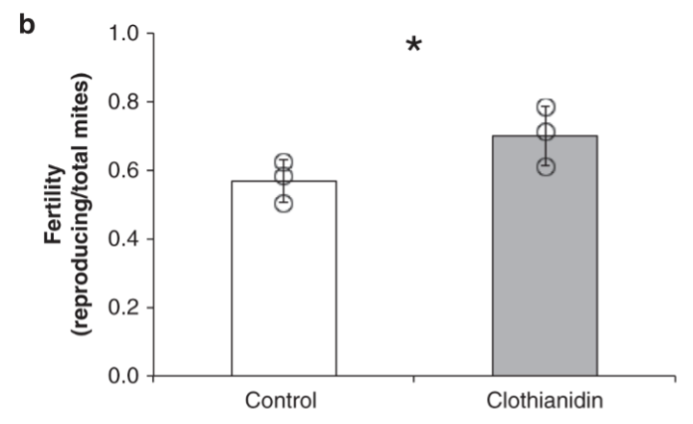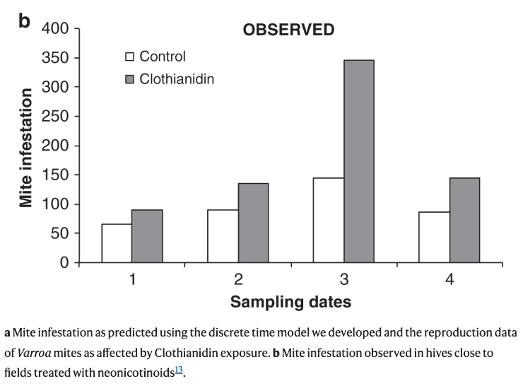 by Véto-pharma
by Véto-pharma Beekeepers have increasingly reported significant spikes in Varroa destructor infestations after moving their bees to certain crops [1]. This phenomenon raises concerns about the interactive effects of pesticides and parasitic pressures on honey bee health. Recently, Bartlett et al. 2024 investigates how neonicotinoid exposure exacerbates varroa mite infestations [2]. This study explores the hypothesis that agrochemical exposure, specifically neonicotinoids, contributes to the increased vulnerability of honey bee colonies to varroa mites and other stressors.
Neonicotinoids, a class of systemic insecticides, have been widely used in agriculture due to their effectiveness against a variety of pests. However, their impact on non-target organisms, particularly pollinators like honey bees, has been a subject of intense research and regulation [3-4]. Neonicotinoids, such as clothianidin and thiamethoxam, are known to disrupt the central nervous system of insects, leading to paralysis and death at high doses [5-6]. At sublethal doses, these chemicals can impair foraging behavior, learning, and memory in bees, ultimately affecting colony health and productivity [7]. In Europe, where neonicotinoids are banned, the use of alternative pesticides has increased. What is the potential impact of these pesticides on varroa mite dynamics and honey bee health?
Bartlett et al. 2024 [2] demonstrates that exposure to field-relevant concentrations of neonicotinoids increases the severity of varroa destructor parasitism in honey bee colonies: “We also find evidence of a detrimental effect of neonicotinoid exposure on colonies, where both mite drop rates […] and mite wash counts […] were higher in colonies exposed to neonicotinoids; colonies exposed to neonicotinoids had on average 5.3 […] more mites drop in 24 h and 1.11 […] more phoretic mites per 100 bees […].”
This interaction can be attributed to several mechanisms:
1. Immunosuppression
Neonicotinoid exposure can weaken the immune system of honey bees, making them more susceptible to varroa mites and associated viral infections [8]. In addition, a recent study published in Naturehighlights a change in mite fertility (reproducing mites out of total mites), showing that mites exposed to Clothianidin exhibited an average increase of 23% in reproducing mites [9]. “Mite fertility (i.e., proportion of reproducing females out of total female mites used in the experiment) on bee pupae treated with 0.01 ppm of Clothianidin at the larval stage was significantly higher than on control bees […] by 23%, on average […]. The observed increase of fertility in mites parasitizing Clothianidin treated bee larvae is possibly due to the fact that their feeding activity is facilitated by the induced immune-suppression of the host.”

Similarly, mite infestation was higher in colonies exposed to Clothianidin: “We found that mite infestation in hives contaminated with Clothianidin could reach a level that is 1.4–2.0 times higher than that observed in uncontaminated hives, according to the season. This result matches quite well the observations carried out under field conditions, where a 1.4–2.4 higher mite infestation was observed in hives placed near corn fields planted with neonicotinoid-coated seeds.”

2. Behavioral Changes
Sublethal doses of neonicotinoids can alter bee behavior, reducing their efficiency in tasks such as grooming, which is crucial for varroa mite control [10]. This behavioral impairment can lead to an increased mite load within the colony.
3. Synergistic Toxicity
Organophosphates and pyrethroids, for instance, have been linked to increased viral loads in bees, where the overall impact on bee health is greater than the sum of individual effects. This can lead to higher mortality rates and reduced colony resilience [11].
Evidence from in vitro and field studies research have provided insights into how these pesticides used in agriculture impact honey bee colonies and varroa mite dynamics:
1. Pyrethroids
These insecticides are widely used for their broad-spectrum activity. Pyrethroids, such as tau-fluvalinate, are employed in beekeeping to control varroa mites. Studies have shown that varroa mites can develop resistance to pyrethroids, making these treatments less effective over time. Resistant mites can proliferate, leading to higher infestation rates [12-14].
2. Organophosphates
These chemicals, like chlorpyrifos, affect the nervous system of insects by inhibiting acetylcholinesterase. Research indicates that organophosphates can cause acute and chronic toxicity in bees, impairing their cognitive functions and immune responses. This can indirectly affect varroa mite management by weakening the colony’s overall health [15].
3. Fungicides
While not primarily targeted at insects, fungicides like chlorothalonil and propiconazole can interact with other pesticides, enhancing their toxicity to bees and potentially affecting varroa mite behavior indirectly. Experiments have demonstrated that fungicides can enhance the toxicity of insecticides, leading to increased mortality and sublethal effects in bees. This can reduce the bees’ ability to cope with varroa mites and other stressors [16].
4. Herbicides
Glyphosate, a widely used herbicide, has been shown to alter the gut microbiota of honey bees, which can impact their overall health and susceptibility to pests and diseases [17].
Field observations by beekeepers have shown a correlation between moving bees to certain crops and subsequent increases in varroa infestations. This has been particularly noted in crops treated with neonicotinoid pesticides [2]. In this study, honey bee colonies exposed to neonicotinoids exhibited higher rates of Varroa mite parasitism compared to control groups.
While genetic diversity within honey bee colonies can improve overall survivability and resilience to stressors [18], the study by Bartlett et al. 2024 [2] indicates that it does not mitigate the negative effects of neonicotinoid exposure on varroa mite infestation rates. Genetic diversity is known to enhance task specialization and disease resistance within colonies, but the overwhelming stress from pesticides appears to overshadow these benefits.
The findings of this study highlight the need to rethink beekeeping practices, particularly in regions where crops are treated with neonicotinoids. These chemicals can worsen varroa infestations, thereby compromising the health of bee colonies. It is therefore essential for beekeepers to be aware of these risks and explore alternative strategies to mitigate the impact of pesticides on their hives. Understanding the complex interactions between neonicotinoids, varroa, and bee health is crucial for developing integrated approaches that address the challenges posed by modern agriculture.
REFERENCES
 by Véto-pharma
by Véto-pharma The contents of this page are intended for the American public. The instructions for use of the miticites mentioned comply with US regulations. Table of contents In the context of
 by Véto-pharma
by Véto-pharma  by Véto-pharma
by Véto-pharma Join the Véto-pharma community and receive our quarterly newsletter as well as our occasional beekeeping news. You can unsubscribe at any time if our content does not suit you, and your data will never be transferred to a third party!
© 2019-2025, Véto-pharma. All rights reserved